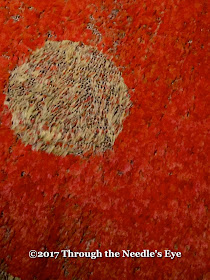In November, I (Teri) taught a workshop for the Baltimore Appliqué Society on this lovely flower basket block, made by Mildred Tahara. I wrote about this stunning quilt in the post, In Praise of Jane Austen: An Album Quilt, including close-up shots of the blocks Mildred made that will be BAS workshops. Elly Sienkiewicz designed the patterns Mildred used.
As I began stitching my model, I pondered the basket. My favorite appliqué method is back-basting, so I knew that would be how I'd construct my basket. I studied the baskets on both Elly's and Mildred's models. (Elly was kind enough to loan me her block.) When Elly first made the block, she used a solid piece of fabric and used reverse appliqué.
 |
| Basket, reverse appliquéd by Elly Sienkiewicz What a perfect fabric for the basket! |
Mildred also reverse appliquéd the basket with a single piece of fabric, but then she appliquéd the rectangles of white on top of it to give the basket an open look.
 |
| Basket appliquéd by Mildred Tahara |
Since I was using Mildred's quilt as my teaching model, I wanted the basket to have the same look; however, I don't think I have the patience that Mildred must have, because I couldn't imagine me trying to appliqué all those skinny rectangles. So I decided to "weave" my basket, using the back-basting method. Here's what I did.
First, I marked every other spoke on the back, and basted them, using one piece of fabric. I then trimmed and appliquéd each of the spokes.
Next, I basted the cross-bar on top of those spokes, trimmed, and appliquéd it.
Here is the back of the piece, where the basket is marked. Note the light marked lines in the stitched spokes, which helped me place the first alternating spokes. Here, I am basting the remaining alternating spokes
The basting lines are marked on the outside of the spokes, so that when they are trimmed and the basting stitches are removed one at a time, the marked lines are my turning lines.
As I stitched these spokes on top of the previous spokes and cross-bar, I got the illusion of having woven the basket fabric. But all I had to do was stitch straight lines...easy peasy!!
After the inside of the basket was finished, I basted one large piece of fabric over the entire basket design—the inside and the outside edges. I marked the basting lines with my white pencil.
First I trimmed—very carefully—along the inside edges and reverse appliquéd the inside of the basket.
After the inside was reverse appliquéd, I appliquéd around the outside edge of the basket, removing just a few basting stitches at a time, not more than an inch or so ahead of my appliqué stitches.
You can see the woven look that is achieved.
And here is my finished basket!
I am nearly finished with the block. I just have a few flowers remaining to create and stitch. I will be teaching the second part of the this block in January, at which point I will share my version with you. It has been great fun to stitch this Flower Basket, inspired by both Elly and Mildred.
There are many ways to stitch a basket. How might you go about weaving an appliquéd basket?


































































